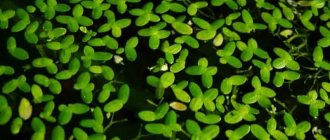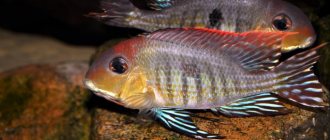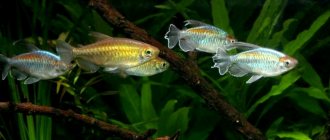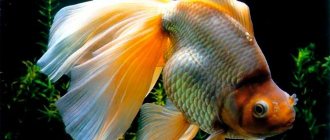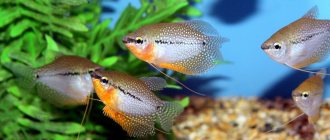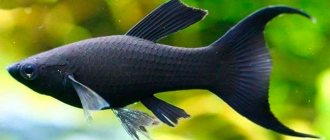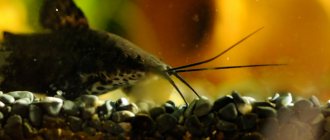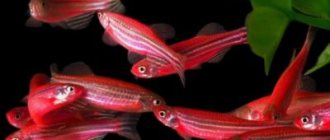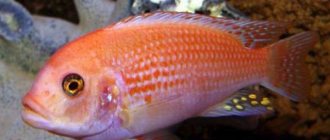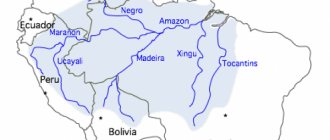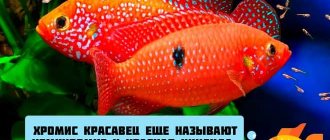This is a classic aquarium fish that appeared in the aquarium hobby thanks to a French military man named Geraud in 1869. Of the first 100 specimens shipped, 22 survived and were successfully bred later that year by another Frenchman, Parisian Pierre Carbonnier. This gives the species the important distinction of being one of the very first aquarium fish imported into Europe.
Synonyms
Russian: Paradise fish, Common macropod Latin: Chaetodon chinensis (Bloch, 1790), Labrus opercularis (Linnaeus, 1758), Macropodus chinensis (Bloch, 1790), Macropodus ctenopsoides (Brind, 1915), Macropodus filamentosus (Oshima, 1919), Macropodus venustus (Cuvier, 1831), Macropodus viridiauratus (Lacepède, 1801)
Etymology
Macropodus: Greek (macro), meaning long and (podos), meaning leg, in reference to the long ventral fins of the genus. opercularis: presumably referring to the dark opercular spot present in this species.
Order: Creepers (Anabantiformes) Family: Macropods or Guramiaceae (Osphronemidae) Genus: Macropodus (Macropodus)
Range and Habitat
Asia: China, south of the Yangtze basin, including Taiwan and Hainan Island, northern and central Vietnam and northeastern Laos.
Introduced* populations exist in a number of countries, including South Korea, Japan, Malaysia, Singapore, India and the USA, mainly through the aquarium trade.
Macropod (Macropodus opercularis) habitats, biotope 1
They inhabit any shallow water bodies, usually with dense thickets of aquatic and coastal vegetation, from the backwaters of large rivers to small streams and irrigation canals on agricultural land. Can live in stagnant water with very low oxygen levels. Found in streams, rice fields and ditches.
*Introduction in biology is the deliberate or accidental relocation of individuals of any species of animals and plants outside their natural range to new habitats.
Homeland of the fish
The homeland of macropods is the clean waters of Korea, China, South Vietnam, and sunny Taiwan. In modern conditions, these representatives of the aquatic world are included in the Red Book. The decline in numbers is due to human development of natural habitats and severe pollution of the natural environment.
Description
The macropod fish is a typical representative of the large labyrinth family. The name of the fish is made up of two Greek concepts: “macro” - large and “podos” - leg. This interesting name was given to the labyrinth fish by the great mind of his time, Carl Linnaeus, who saw a striking resemblance to a “leg” in the large anal fin.
A distinctive feature of labyrinth fish is an additional respiratory organ. In appearance, it is similar to a small sac, penetrated by small blood vessels, located next to the respiratory gills. Thanks to this organ, macropods consume atmospheric air, which is so necessary for life in the wetlands of rivers. The lack of river flow and large amounts of green organic matter reduces the concentration of dissolved oxygen.
Appearance of a macropod fish
Appearance
Macropods are quite large in size. The length of the body reaches 10 cm. Their body is elongated, the head is pointed, with bulging eyes. Their unpaired fins are well developed. The tail is quite long (3 cm), thanks to which the labyrinths visually look even larger. The pelvic fins are transformed into thin threads; they serve as tactile organs, allowing excellent orientation in cloudy water.
The color of the macropods is attractive. The main tone of the body is blue or intense olive with uniform stripes throughout the body. Near the respiratory gills there is a shiny blue “eye” framed by a visible red spot. The brightness of the color depends on the internal temperature of the aquatic environment and the general degree of excitement of the active fish.
Interesting fact. Selectors have developed a number of interesting color patterns, such as albino forms, which are no different in appearance from the classical species.
History of origin
Individuals were first introduced in 1869 by the famous consul from France Simon. At this time, there was no information about the ability of labyrinth fish to swallow air from the surface of the water, so during transportation they were kept in strong, sealed barrels. Therefore, only 22 labyrinth fish out of 100 survived this difficult journey.
The macropods were presented as a gift to the eminent French aquarist Pierre Carbonnier, who quickly managed to reproduce the fish. In 1876, the labyrinthine ones first came to enlightened Berlin. This event marked the beginning of the spread of a new species.
Behavior
The representative of the labyrinth family has a rather warlike character. Males can fight with each other; this point must also be taken into account when keeping fish. They are of little interest to other inhabitants. It is advisable to keep the male alone or with the female, providing her with shelter.
Male macropod
Lifespan
The lifespan of a macropod depends entirely on its habitat. They have excellent immunity and good adaptive abilities. With proper care and a clean aquarium, the fish can live up to 8-10 years. Under the influence of destructive factors, this period is reduced to 4 years.
Description
The body is strongly compressed laterally. The dorsal, anal and caudal fins are strongly developed, and in the male they are elongated and end in filaments.
Macropod (Macropodus opercularis) male, appearance
Macropod (Macropodus opercularis) female, appearance
Alternating wide stripes of red and green colors run along the brownish or greenish-brownish background of the body. The dorsal and anal fins are bluish in color with red thread-like outgrowths, the caudal fin is red.
Macropod (Macropodus opercularis) close-up, appearance
The color intensity increases sharply with increasing temperature, as well as during the mating season.
Size:
Maximum standard length 70 - 80 mm.
Types of macropods
There are several types of fish, interesting and original in their own way.
Classical
The natural habitat of this fish is China. The common macropod comes in the following colors:
- Blue is the main tone of the body, purple strokes appear on the head and back;
- The classic look has a brown body, belly and head decorated with light blue tints, sides with greenish-blue and red streaks;
- Truly unique albino macropods have a transparent body evenly covered with yellow-orange stripes.
Redback
The red-backed macropod is beautiful, the first mention of which was in 2002. Most of the body is intense red with a pronounced silver tint. Soft lighting gives emerald highlights. The tail and fin areas are painted in a light blue tone with a striking white edging. The striking color of this species does not depend on gender. The only thing that makes the male stand out is his voluminous, elongated fins.
Redback macropod
Black
The first detailed description of this species was published in 1936. When at rest, the fish is colored brown or intense gray.
The voluminous tail of this black macropod is black at the base, then it turns into a bright orange tone, the final outline is framed by a blue stripe. In addition to the two main rays, the fish have additional ones - located in the middle of the caudal fin and colored intensely black. And the fin itself is decorated with darker stripes.
Black macropod
Behavior and Compatibility
Males are territorially aggressive, a behavior that becomes more pronounced during the breeding season, and should not be housed together unless the tank is very large. It is also advisable to provide two or more females per male to disperse their attention.
Macropod (Macropodus opercularis) male sparring, behavior
Fish that were raised separately behave aggressively in a common aquarium. After growing together, they can be kept with any other fish, as well as several pairs together.
Feeding
The predatory Macropod is not picky about its diet. To expand the diet, dry, live and frozen food is used.
For this species, the presence of carotene in food is important; a lack of this substance leads to faded color.
Recommended diet:
| Dry | Alive | Frozen |
| Tetra rubin | Bloodworm | Cyclops |
| Sera san | Koretra | Daphnia |
| Black mosquito (larva) | ||
| Bloodworm | ||
| Koretra | ||
| Moina | ||
| Shrimps |
All of these products can be combined or replaced.
Aquarium
An aquarium with basic dimensions of 80 * 30 cm should be the minimum for a pair of these fish.
A fairly adaptable species that will do well in a wide variety of aquariums, although it does not really like bright lighting. But it looks great in aquariums densely planted, where it really shows off its rich color.
The chemical composition of the water is not critical. They feel equally comfortable in both soft and relatively hard, slightly sour or neutral water. When kept, the optimal temperature in the aquarium is 24 - 26 ° C; raising the temperature to 28 and even 30 ° C is beneficial.
Driftwood - roots and branches can be used and placed to create a few shade spots, with some floating or surface vegetation to be added.
A few handfuls of dried leaves (beech or oak) will complete the natural look.
Water parameters:
Temperature: 16 - 26° C pH: 6.0 - 8.0 Hardness: 5 - 19° dGH
Filtration with aeration are not necessary, but they prefer clean water and installation of equipment is still necessary. Keep water movement to a minimum. Water changes are carried out weekly by 1/4.
Possible diseases
Macropods are resistant to diseases, but if the conditions are not at all suitable or the diet is unbalanced, they can get sick:
- Ichthyophthyriasis . Whitish dots appear on the body of the fish. It can be cured by raising the temperature of the water and giving medications against this disease.
- Tuberculosis . It develops when the owner of the aquarium neglects cleaning - the fish die due to poor hygiene.
- Parasites (carp lice or nematodes) . Macropods can be infected through untreated food, plants or soil. The following will help against pests: a solution of potassium permanganate, special preparations, or food with Piperazine mixed in.
- Fin rot . It can be seen by the way the fins of the individual are destroyed. If the disease is not advanced, it is treated with antibiotics.
To prevent these diseases, pets should be given close attention. Macropods are not an endangered species, however, they are listed in the Red Book for the sake of precaution, since with the development of territories, pollution of the environment, including water bodies, also increases, which can quickly lead to mass death and disappearance of “paradise” fish.
Macropods fascinate with their perfect beauty and grace, and they also bring invaluable benefits by cleaning the aquarium from pests. Caring for handsome dogs is not difficult, but they still require, like all living beings, responsible attitude and care.
Breeding
Breeding is easy.
Reproduction is carried out under the conditions described for all labyrinths. Aquariums with a volume of at least 8-12 liters are used as spawning grounds. The water temperature is 22-24° C, but 28° is also possible. Plants should be placed in the spawning area in the amount necessary to shelter the female from the male pursuing her.
The spawning aquarium should have a lid that fits as tightly as possible (some breeders use cling film), because the fry need access to a layer of warm, moist air, without which the development of the labyrinth organ may be impaired.
Before breeding, the producers must be separated 2-3 weeks before breeding.
The male builds a nest from air bubbles with a diameter of 5-6 cm and a height of 1-2 cm. Spawning occurs 1-2 days after the start of nest construction. The caviar is yellowish in color, light and therefore rises to the surface of the water. The male places the eggs in the nest. Spawning continues for several hours. During this time, the female spawns up to 1000 eggs; after the end of spawning, it must be removed.
Macropod (M. opercularis) male, aerial nest, caring for offspring.
After approximately one and a half days (faster or slower depending on temperature), the larvae hatch, after 3-4 days the juveniles begin to swim freely.
At this time, the male must be removed and the fry must be fed with ciliates, rotifers or “dust”, or, in extreme cases, egg yolk. When the fry begin to swim freely, the male loses interest in them and should be removed at this stage.
The fry grow quickly, 7-10 days after their birth they can already feed on the nauplii of Artemia and Cyclops. Due to the uneven growth of the fry, it is necessary to sort them, selecting those that are suitable in size.
When favorable conditions are created, life expectancy is up to 10 years.
Aquarium Basics
Paradise fish are hardy and can live in the most unfavorable conditions - in small tanks with poor aeration and periodic temperature fluctuations.
The capacity of just over 20 liters allows you to contain one Macropod. You definitely need to install a lid, your pet loves to jump out of the water. For each individual, a separate shelter is created as far from each other as possible in order to eliminate competition for territory.
The following water quality indicators are acceptable:
| Rigidity | Acidity | Temperature |
| 5-19 °dH | 6-8 pH | +16…+26 °С |
For this species, the current should not be strong; it can be completely removed, since stagnant bodies of water are the natural habitat of fish. Replacements are made in the amount of 25% of the total volume no more than once a week.
Algae in an aquarium can be anything. They prefer greens with a developed root system and spreading along the water. For the latter, regular thinning is necessary so that the fish can rise to breathe air; this is especially true for tanks without additional aeration.
Dark soil is mandatory for Macropods; it does not irritate already restless pets and against this background they look more impressive. You should not choose artificial or painted stones to prevent contamination of the liquid with toxins and dyes. The bottom must be cleaned regularly with a siphon before changes, that is, once a week.
The aquarium equipment may be weak. Filtration is sufficient at a minimum level. Aeration and a heater may not be installed, but this is only relevant if only Macropods live in the artificial reservoir.
When choosing lighting devices, they focus on vegetation; fish do not need light. It is better to give preference to soft diffused lighting; be sure to turn off the backlight at night. The walls of the container should not be exposed to sunlight.
Notes
The coloring of fish brought from their homeland, as well as their first generations, was much brighter than at present. Apparently, this is explained by the lack of selection work and inbreeding over many generations. Deterioration of color may be the result of being kept in too low a temperature and low light conditions.
Red macropod (Macropodus opercularis super red) selection form
Wild specimens are rare in aquariums as this species is bred commercially. There are also a number of selectively bred ornamental strains, including xanthine, albino, red, blue and stripeless forms.
Blue macropod (M. opercularis blue redstripe) selection form
It can be distinguished from its relatives by the following combination of characteristics: the caudal fin is forked; dark brown opercular spot with reddish posterior margin; 7-11 blue body stripes on a red background; a dark stripe crossing the eye, connecting the macula operculare to the eye; the upper part of the head and the area in front of the dorsal fin with dark spots; the rear edges of the body scales are not darker than the scales themselves.
Albino macropod (Macropodus opercularis albino) selection form
Like others in the suborder Anabantoidei, this species possesses an accessory respiratory organ known as the labyrinth, which allows the fish to breathe atmospheric air. Consisting of paired suprabronchial organs formed by expansion of the epibranchial (upper) portion of the first branchial arch and located in a chamber above the gills, it contains many highly vascularized* folded flaps of skin that function as a large respiratory surface. Its structure varies in complexity between species and tends to be more developed in those living in harsher environments.
*Vascularization provides blood vessels and, therefore, blood to organs, areas and parts of the body.
Read the article about the first breeding of Macropod >>>
Diseases
All labyrinthids are prone to mycobacteriosis, and macropods are no exception. With good care, it may not appear at all. Quarantine measures will not bring results, since this disease is chronic. Often, the disease manifests itself when the animal is stressed, its immunity decreases due to poor living conditions and poor diet.
Symptoms of mycobacteriosis
The disease manifests itself as weight loss, loss of appetite, ulcers, dropsy and ruffled scales. If these symptoms manifest themselves, then eliminating them will be very difficult. You can use a special antibacterial agent Baktopur Direct. Treatment can be carried out both in a general aquarium and in a fish tank.
Other diseases are not specific and can affect any fish, regardless of its species.
Nutrition
Macropod is a predatory fish, so in nature it prefers live food, although it also feeds on plants. In natural reservoirs, the main food of this fish are small inhabitants, insects, which the macropod can swallow, jumping out of the water.
In aquariums, macropods eat all types of fish food. The most preferable for these beauties are live bloodworms and tubifex worms. Frozen shrimp, black mosquito larvae, cyclops, daphnia must be thawed before feeding. Pieces of homemade minced meat are a delicacy for paradise fish, but such a product should be a rare delicacy. Dry food containing carotene improves the brightness of the fish's colors, but there is no need to make them the basis of the diet.
The macropod is always hungry - it eats everything and a lot, it knows no limits. To avoid gluttony, feed little by little, twice a day. In the aquarium, these orderlies prevent the excessive reproduction of worms and snails.
